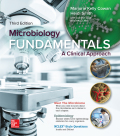
Concept explainers
(i)
To create:
The frame shift mutation from the DNA sequence: TAC CAG ATA CAC TCC CCT
Introduction:
The mutation which occurs in introns is insertion or deletion. It can cause shift in open reading frame of the gene sequence, and can change the amino acid sequence of the coded protein.
(i)
Explanation of Solution
Change in the genetic sequence of DNA, by addition and deletion of nucleotides, results in gene mutation.
Insertion mutation: This mutation occurs by insertion of one or more nucleotides in the DNA sequence. Insertion mutation is a type of frame shift mutation, as insertion of a single
Original DNA sequence:
Frame shift due to insertion mutation:
Deletion mutation: This mutation occurs due to removal of one or more nucleotides from DNA sequence. Deletion mutation is a type of frame shift mutation, as removal of a single nucleotide shifts the whole reading frame in the DNA.
Original DNA sequence:
Frame shift due to deletion mutation:
(ii)
To create:
The silent mutation from the DNA sequence: TAC CAG ATA CAC TCC CCT
Introduction:
The mutations in the codons that do not change the particular amino acid in the given polypeptide chain are called synonymous mutations. They are also called silent mutations because they cause no change in the structure of the protein.
(ii)
Explanation of Solution
Silent mutation involves base substitution which results in same amino acids that was encoded by previous nucleotidal sequence.
Original DNA sequence:
Corresponding RNA sequence:
Amino acid sequence: Tyrosine Glutamine Methionine Histidine Serine Proline
Silent mutation:
Corresponding RNA sequence:
Amino acid sequence: Tyrosine Glutamine Methionine Histidine Serine Proline
(iii)
To create:
The nonsense mutation from the DNA sequence: TAC CAG ATA CAC TCC CCT
Introduction:
The nonsense mutations are the mutations that generate the stop codon. The generated stop codon terminates the translational process and thus, the protein structure will not be formed because no more amino acids will be added to the sequence.
(iii)
Explanation of Solution
Nonsense mutation involves substitution of a single base pair that yields a stop codon.
Original DNA sequence:
Nonsense mutation:
Corresponding RNA sequence:
Want to see more full solutions like this?
Chapter 8 Solutions
Microbiology Fundamentals: A Clinical Approach
- Amino Acid Coclow TABle 3' Gly Phe Leu (G) (F) (L) 3- Val (V) Arg (R) Ser (S) Ala (A) Lys (K) CAG G Glu Asp (E) (D) Ser (S) CCCAGUCAGUCAGUCAG 0204 C U A G C Asn (N) G 4 A AGU C GU (5) AC C UGA A G5 C CUGACUGACUGACUGAC Thr (T) Met (M) lle £€ (1) U 4 G Tyr Σε (Y) U Cys (C) C A G Trp (W) 3' U C A Leu בוט His Pro (P) ££ (H) Gin (Q) Arg 흐름 (R) (L) Start Stop 8. Transcription and Translation Practice: (Video 10-1 and 10-2) A. Below is the sense strand of a DNA gene. Using the sense strand, create the antisense DNA strand and label the 5' and 3' ends. B. Use the antisense strand that you create in part A as a template to create the mRNA transcript of the gene and label the 5' and 3' ends. C. Translate the mRNA you produced in part B into the polypeptide sequence making sure to follow all the rules of translation. 5'-AGCATGACTAATAGTTGTTGAGCTGTC-3' (sense strand) 4arrow_forwardWhat is the structure and function of Eukaryotic cells, including their organelles? How are Eukaryotic cells different than Prokaryotic cells, in terms of evolution which form of the cell might have came first? How do Eukaryotic cells become malignant (cancerous)?arrow_forwardWhat are the roles of DNA and proteins inside of the cell? What are the building blocks or molecular components of the DNA and proteins? How are proteins produced within the cell? What connection is there between DNA, proteins, and the cell cycle? What is the relationship between DNA, proteins, and Cancer?arrow_forward
- please fill in the empty sports, thank you!arrow_forwardIn one paragraph show how atoms and they're structure are related to the structure of dna and proteins. Talk about what atoms are. what they're made of, why chemical bonding is important to DNA?arrow_forwardWhat are the structure and properties of atoms and chemical bonds (especially how they relate to DNA and proteins).arrow_forward
- The Sentinel Cell: Nature’s Answer to Cancer?arrow_forwardMolecular Biology Question You are working to characterize a novel protein in mice. Analysis shows that high levels of the primary transcript that codes for this protein are found in tissue from the brain, muscle, liver, and pancreas. However, an antibody that recognizes the C-terminal portion of the protein indicates that the protein is present in brain, muscle, and liver, but not in the pancreas. What is the most likely explanation for this result?arrow_forwardMolecular Biology Explain/discuss how “slow stop” and “quick/fast stop” mutants wereused to identify different protein involved in DNA replication in E. coli.arrow_forward
 Human Heredity: Principles and Issues (MindTap Co...BiologyISBN:9781305251052Author:Michael CummingsPublisher:Cengage Learning
Human Heredity: Principles and Issues (MindTap Co...BiologyISBN:9781305251052Author:Michael CummingsPublisher:Cengage Learning Biology Today and Tomorrow without Physiology (Mi...BiologyISBN:9781305117396Author:Cecie Starr, Christine Evers, Lisa StarrPublisher:Cengage Learning
Biology Today and Tomorrow without Physiology (Mi...BiologyISBN:9781305117396Author:Cecie Starr, Christine Evers, Lisa StarrPublisher:Cengage Learning Biology (MindTap Course List)BiologyISBN:9781337392938Author:Eldra Solomon, Charles Martin, Diana W. Martin, Linda R. BergPublisher:Cengage Learning
Biology (MindTap Course List)BiologyISBN:9781337392938Author:Eldra Solomon, Charles Martin, Diana W. Martin, Linda R. BergPublisher:Cengage Learning Concepts of BiologyBiologyISBN:9781938168116Author:Samantha Fowler, Rebecca Roush, James WisePublisher:OpenStax College
Concepts of BiologyBiologyISBN:9781938168116Author:Samantha Fowler, Rebecca Roush, James WisePublisher:OpenStax College Anatomy & PhysiologyBiologyISBN:9781938168130Author:Kelly A. Young, James A. Wise, Peter DeSaix, Dean H. Kruse, Brandon Poe, Eddie Johnson, Jody E. Johnson, Oksana Korol, J. Gordon Betts, Mark WomblePublisher:OpenStax College
Anatomy & PhysiologyBiologyISBN:9781938168130Author:Kelly A. Young, James A. Wise, Peter DeSaix, Dean H. Kruse, Brandon Poe, Eddie Johnson, Jody E. Johnson, Oksana Korol, J. Gordon Betts, Mark WomblePublisher:OpenStax College Biology 2eBiologyISBN:9781947172517Author:Matthew Douglas, Jung Choi, Mary Ann ClarkPublisher:OpenStax
Biology 2eBiologyISBN:9781947172517Author:Matthew Douglas, Jung Choi, Mary Ann ClarkPublisher:OpenStax





